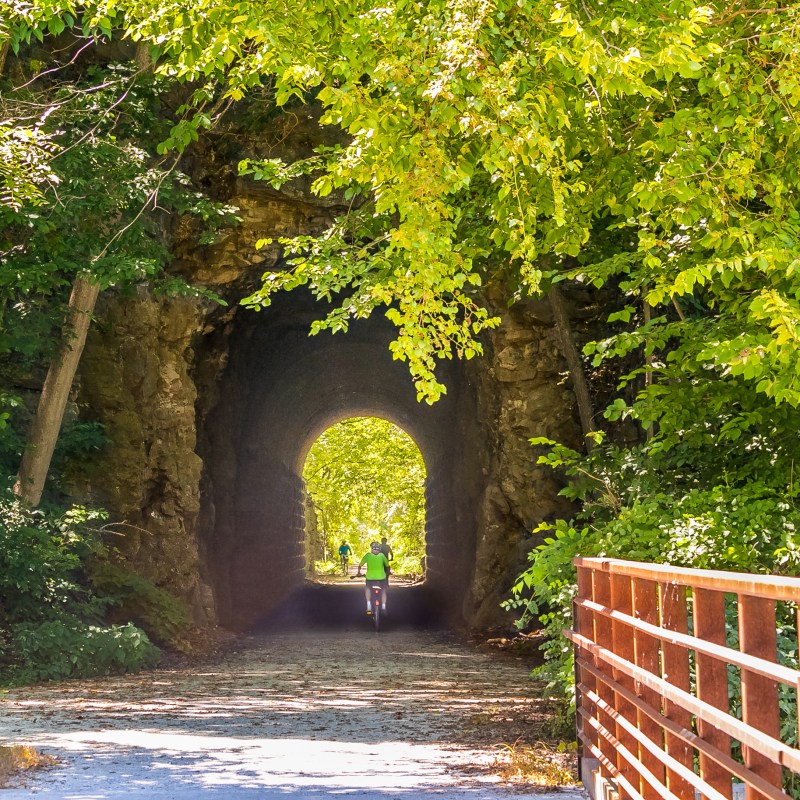
Sitting smack dab in the middle of the country, Missouri is easy to pass through. But slow down, get off the interstate, and take a look around at the Show Me State’s diverse scenery. There may not be the towering peaks that you see in the Rockies, but there’s lots of running water with major rivers, smaller streams, springs, smaller mountains called the Ozarks, and caves. In fact, Missouri’s other sobriquet is the Cave State. Let’s get walking.
Videos by TravelAwaits

1. Ozark Trail, Peck Ranch Conservation Area
Fremont
This huge — for Missouri — conservation area is near Winona in the southeast part of the state. It’s almost 23,000 acres, and lots of wildlife is supported in the immediate region: deer, turkey, bobcats, bears and — just reintroduced — elk. To see all this, try a piece of the Ozark Trail. The OT is 500 miles long, but we’re only interested in the portion in Peck Ranch. It’s only about nine miles and gets you clear streams, old-growth hardwood forests, and even strenuous climbs to rounded peaks.
Pro Tip: look for eastern collared lizards in open areas.

2. Mastodon State Historic Site
Imperial
This site is south of St. Louis on Interstate 55, and it contains the Kimmswick Bone Bed, which shows that mastodons coexisted with man in eastern North America. The bones themselves are interesting, as is their story. There’s also a nice walk along limestone bluffs. It’s just about two miles long and worth the stroll, with some interesting views of the area from atop the bluff.
Pro Tip: Check out the on-site Callison Memorial Bird Sanctuary, which is full of wildflowers.

3. Katy Trail
Marthasville
This is the granddaddy of all rails-to-trails efforts. About 200 miles of the old Missouri-Kansas-Texas (MKT) rail line was converted to a bike trail, but walkers are welcome. It’s easy to access along its route, and my favorite place to hop on is in Marthasville. It’s a cute town with services and a great place to walk as far as you want. The Missouri River is your constant companion as you walk. The trail is flat thanks to the original railroad grade.
Pro Tip: Keep to the right when walking so cyclists don’t have to dodge you.

4. Big Piney Trail, Paddy Creek Wilderness
Plato
This walk in the Paddy Creek Wilderness has lots of solitude and attitude. You are in a wilderness area and you are in charge of your own safety. The hike is located south of Rolla, near Licking (technically in Plato). The entire loop is 17 miles, but you can bite off small chunks to enjoy the wind in the pine forest. At about two miles into this walk, you climb a limestone hill through a canyon and end up on a bluff with wonderful views. If you want a short hike, this is a good place to turn around.
Pro Tip: Poison ivy lurks near the trail.

5. Sheppard Point Trail, Trail Of Tears State Park
Jackson
The Trail of Tears commemorates the forced removal of 13,000 Cherokee people from their homelands in the east. This area is where thousands crossed the Mississippi near Cape Girardeau. The park is just 10 miles north of Cape Girardeau, off Interstate 55. This hike is under four miles long but has some great views of the Mississippi River from a bluff, and you get a bonus peek into the flatlands of Southern Illinois. Make time to visit the Vancill Hollow Natural Area inside the park, which features plants more common to the eastern United States, including beech, tulip poplar, and cucumber magnolia trees.
Pro Tip: Mosquito repellent.

6. Devils Icebox Trail, Rock Bridge Memorial State Park
Boone County
I had to list this hike simply because of the great name. It’s in the Rock Bridge Memorial State Park and is only about a half-mile, but it’s fun. Before you get to the icebox, you’ll have to duck your head under the rock bridge. It’s a huge stone with a walkway worn away by millions of years of water rushing through. You eventually end up at a deep sinkhole — where a cave roof collapsed, leaving a deep hole: the Icebox. There are steps that take you down to the bottom, and you realize how the area got its name: It’s cool in the hole. This park is in Boone County, just about 10 miles west of Columbia on Interstate 70.
Pro Tip: Make time to tour nearby Connor’s Cave. Guided tours are given every day from 1 to 4 in the afternoon. Park rangers will even loan you a helmet and a light.

7. Big Spring Trail
Ellsinore
This is my pick for the best hike in Missouri. Check out TravelAwaits’ picks for the best hikes in all 50 states here. This hike is in the Ozark National Scenic Riverways, in Ellsinore near Van Buren. It used to be a state park, but the people of Missouri gave the area to the National Park Service. This trail follows the Big Spring branch of the nearby Current River, which is fed by the spring. That’s why it’s so blue. The spring puts out almost 300 million gallons of water per day and carries 70 tons of dissolved limestone. It’s a lot of water. The trail gives you great views of the beginnings of the Ozark Mountains, some of the oldest mountains in the U.S. Near the end of the walk, you get a view of the spring itself, as it jumps out of a hillside. The folks who know about these things say some of that water has traveled 45 miles underground to get here.
This region of Missouri has a bunch of big springs: Alley, Pulltite, Blue, and Round. They are all in a relatively close range from Big Spring, so enjoy a springs tour. Alley Spring near Eminence is just as blue as Big Spring, unless it’s been raining. Then, Alley gushes up some brown water.
Pro Tip: Do NOT drink the spring water. It’s as unhealthy as surface water, since it started that way.

8. Mina Sauk Falls Trail (And Part Of The Ozark Trail)
Iron And Reynolds Counties
Mina Sauk Falls Trail is only three miles long and progresses in a loop, but you will get your Midwest exercise as you start at the top of Missouri’s highest “mountain” — Taum Sauk. Taum Sauk is 1,772 feet high and you’ll walk uphill at the end of this hike. This walk also features a great waterfall, and you’ll visit a number of glades inhabited by lizards, toads, and sun-loving snakes. Glades, also called balds, are created due to the underlying geology: In this area, the rock outcroppings are a red volcanic rock called rhyolite. Park managers use controlled burns to keep out flora that try to inhabit the glades, like cedar trees.
Mina Sauk Falls aren’t always flowing. The best viewing is usually in the spring or fall, thanks to seasonal rainfall. The falls are 130 feet tall and cascade down a series of granite ledges.
While you are at Taum Sauk, you can also take a quick detour and see the Johnson Shut-Ins along the Shut-Ins Trail. In fact, you could do a 12-mile hike from Taum Sauk to the Shut-Ins, but then you’d have to figure out how to return to your car. The Shut-Ins are huge big boulders in the Black River that have been smoothed and scoured by the water. The rock: again, rhyolite volcanic rock. The river goes into a narrow gorge and picks up speed, thanks to the narrows. On a hot summer day, there’s no finer way to cool off than to jump into the river and sit among the rocks. Some are almost natural chairs and couches for overheated hikers.
This whole region is infused with granite rocks, and the most stunning are Elephant Rocks at the state park of the same name. It’s only a 40-minute drive to Elephant Rocks. There is a one-mile trail around the rocks and you are encouraged, almost required, to climb on these ancient stones.
They were created through volcanic action, and over time, they were exposed and rounded off by weather. With some imagination, they do look like elephants … big ones. The oldest granite quarry in the state is just outside the park. The rock here was used to build the famous Eads Bridge piers in St. Louis and the state capitol buildings of Illinois and Iowa.
Pro Tip: Rock collecting is prohibited and no rock climbing equipment is allowed.
With these Missouri hikes and natural sites, I’ve tried to give a flavor of the state. Missouri has a varied topography, with native prairies north of the Missouri River, which bisects the state, flowing east to west. The hills are south of the river, where the glaciers didn’t get them.
This article is presented by KEEN Footwear. My Targhee III casual brogues were a big help on some of these hikes, especially climbing around Elephant Rocks, thanks to their good traction. The boots are comfortable and amazingly cool too, considering some recent 90-degree days in the region. Shop KEEN’s Targhees and other hiking shoes here.

